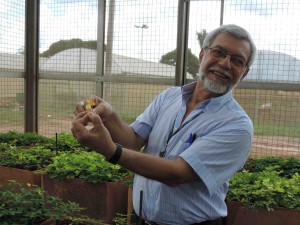 The light blogging during the past couple of weeks has been due to me travelling and Jeremy being submerged in work. We’re trying to get back into it, but things are still going to be a bit slow as we catch up. Just to tide you over for a while, though, here’s a quick taste of where I went. The guy on the right is Dr José Valls of Cenargen, which is part of Embrapa and houses the national plant genetic resources collection of Brazil. He’s showing us (that would be myself and Nora Castañeda of CIAT, who took the photo, which you can see better by clicking on it) the entire range of colour diversity in wild peanut flowers. He should know about that, because he is widely recognized as one of the world’s foremost authorities on these plants, and manages one of the world’s most important collections of Arachis diversity. And here’s a quick view of only part of it, in which you can probably see about 50 (out of a total of maybe 80) different wild relatives of the peanut.
The light blogging during the past couple of weeks has been due to me travelling and Jeremy being submerged in work. We’re trying to get back into it, but things are still going to be a bit slow as we catch up. Just to tide you over for a while, though, here’s a quick taste of where I went. The guy on the right is Dr José Valls of Cenargen, which is part of Embrapa and houses the national plant genetic resources collection of Brazil. He’s showing us (that would be myself and Nora Castañeda of CIAT, who took the photo, which you can see better by clicking on it) the entire range of colour diversity in wild peanut flowers. He should know about that, because he is widely recognized as one of the world’s foremost authorities on these plants, and manages one of the world’s most important collections of Arachis diversity. And here’s a quick view of only part of it, in which you can probably see about 50 (out of a total of maybe 80) different wild relatives of the peanut.
It is efforts such as those of José and a small band of like-minded peanut taxonomists, geneticists and breeders around the world that have led to the success of the peanut from the American South to East Timor, by way of Africa.
Incidentally, though I call, rather facetiously, José greenhouse a hotspot of agrobiodiversity in my title here, he pointed out to me that he thinks the centroid of wild Arachis species diversity is probably within walking distance of his desk in Brasilia. I think we have the data to test that…
